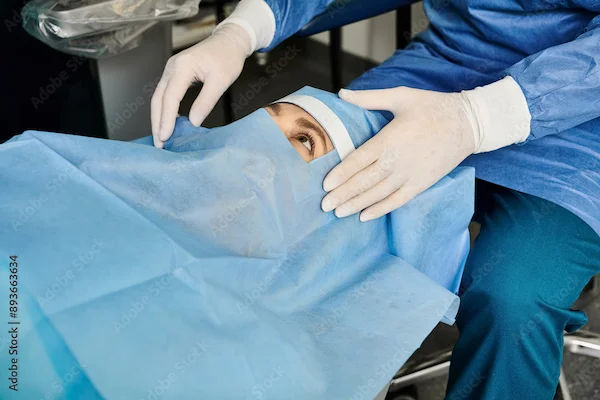How To Reduce Cylindrical Number?
Learn natural and medical ways to reduce cylindrical numbers (astigmatism). Explore eye exercises, corrective lenses, and potential treatments that can help improve vision and manage astigmatism effectively.

Written by
Last updated on 3rd Jul, 2025
If you’ve been told that you have a high cylindrical number (also known as astigmatism) in your eye prescription, you might be wondering what it means and how to reduce it. Astigmatism is a common eye condition that affects how light enters your eye, leading to blurred or distorted vision. The good news is that it can be managed effectively with the right approach.
This article will help you understand astigmatism, its causes, symptoms, and practical ways to reduce its impact on your vision and overall eye health.
What is Astigmatism?
Astigmatism occurs when the cornea (the clear front surface of your eye) or the lens inside your eye has an irregular shape. Instead of being perfectly round like a basketball, it’s shaped more like a football. This irregularity causes light to focus unevenly on the retina, leading to blurred or distorted vision at all distances.
Symptoms of Astigmatism:
If you have astigmatism, you may experience:
Blurry or distorted vision (both near and far)
Eye strain or discomfort
Headaches (especially after reading or screen use)
Difficulty seeing clearly at night
Squinting to see better
Causes of Astigmatism
Astigmatism can be caused by:
Genetics (often present from birth)
Eye injuries or surgeries that change the cornea’s shape
Keratoconus (a condition where the cornea thins and bulges outward)
Aging (changes in the lens over time)
Consult Top Ophthalmologists For More Causes Of Astigmatism
How to Reduce Cylindrical Number?
While astigmatism cannot be completely "cured" without medical intervention, certain lifestyle changes and treatments can help reduce its impact and improve vision clarity.
1. Wear Corrective Lenses
The most common and effective way to manage astigmatism is by wearing:
Glasses: Specially designed lenses compensate for the irregular curvature of your cornea.
Contact Lenses: Toric lenses (special contacts for astigmatism) provide clearer vision than regular lenses.
2. Consider Refractive Surgery
If you want a long-term solution, you may explore:
LASIK: Reshapes the cornea using a laser.
PRK (Photorefractive Keratectomy): Another laser procedure for corneal reshaping.
ICL (Implantable Collamer Lens): A lens implanted inside the eye for severe astigmatism.
Consult Top Ophthalmologists For More Information
3. Eye Exercises (May Help with Mild Cases)
While eye exercises won’t eliminate astigmatism, they can reduce eye strain and improve focus. Try:
The 20-20-20 Rule: Every 20 minutes, look at something 20 feet away for 20 seconds.
Focus Shifting: Alternate focus between near and far objects.
Palming: Rub your hands together to warm them, then gently place them over closed eyes for relaxation.
4. Maintain Good Eye Health
Eat a Balanced Diet: Foods rich in Vitamin A (carrots, spinach), Omega-3 (fish), and antioxidants (berries) support eye health.
Stay Hydrated: Dry eyes can worsen astigmatism symptoms.
Protect Your Eyes from Strain: Limit screen time, use blue light filters, and ensure proper lighting.
5. Regular Eye Check-ups
Since astigmatism can change over time, annual eye exams help monitor your vision and adjust prescriptions if needed.
When to See a Doctor?
If you experience:
Sudden vision changes
Severe headaches or eye pain
Difficulty seeing at night
Double vision
It’s best to consult an eye specialist immediately.
Conclusion
Astigmatism is common and manageable. While you can’t completely eliminate a cylindrical number without medical help, wearing corrective lenses, considering surgery, practicing eye exercises, and maintaining good eye health can significantly improve your vision.
If you’re concerned about your astigmatism or need an eye check-up, book a consultation with an Apollo24|7 eye specialist today for personalized care. Stay proactive about your eye health—clear vision leads to a better quality of life!
Consult Top Ophthalmologists
Consult Top Ophthalmologists For More Causes Of Astigmatism

Dr Rajesh Rastogi
Ophthalmologist
33 Years • MBBS, MS Ophthalmology
New Delhi
Rotary Diabetic Centre, New Delhi
Dr. S Venkateswaran
Ophthalmologist
35 Years • MBBS, PGD (OPTHALMOLOGY)
Tiruvannamalai
Shiva Eye And General Hospital, Tiruvannamalai

Dr. Sneha T Khurana
Ophthalmologist
9 Years • MBBS, MS Ophthalmology
Gurugram
GS multispeciality clinic, Gurugram
Dr. V.chittibabu
Ophthalmologist
30 Years • MBBS, MS
Vellore
Krupa Eye Clinic, Vellore
Dr. Akashdipta Saha
Ophthalmologist
4 Years • MBBS, MD(Ophthalmology), Fellowship in Retina & Vitreous
Delhi
AIIMS, Delhi
Consult Top Ophthalmologists For More Information

Dr Rajesh Rastogi
Ophthalmologist
33 Years • MBBS, MS Ophthalmology
New Delhi
Rotary Diabetic Centre, New Delhi
Dr. S Venkateswaran
Ophthalmologist
35 Years • MBBS, PGD (OPTHALMOLOGY)
Tiruvannamalai
Shiva Eye And General Hospital, Tiruvannamalai

Dr. Sneha T Khurana
Ophthalmologist
9 Years • MBBS, MS Ophthalmology
Gurugram
GS multispeciality clinic, Gurugram
Dr. V.chittibabu
Ophthalmologist
30 Years • MBBS, MS
Vellore
Krupa Eye Clinic, Vellore
Dr. Akashdipta Saha
Ophthalmologist
4 Years • MBBS, MD(Ophthalmology), Fellowship in Retina & Vitreous
Delhi
AIIMS, Delhi
Consult Top Ophthalmologists

Dr Rajesh Rastogi
Ophthalmologist
33 Years • MBBS, MS Ophthalmology
New Delhi
Rotary Diabetic Centre, New Delhi
Dr. S Venkateswaran
Ophthalmologist
35 Years • MBBS, PGD (OPTHALMOLOGY)
Tiruvannamalai
Shiva Eye And General Hospital, Tiruvannamalai

Dr. Sneha T Khurana
Ophthalmologist
9 Years • MBBS, MS Ophthalmology
Gurugram
GS multispeciality clinic, Gurugram
Dr. V.chittibabu
Ophthalmologist
30 Years • MBBS, MS
Vellore
Krupa Eye Clinic, Vellore
Dr. Akashdipta Saha
Ophthalmologist
4 Years • MBBS, MD(Ophthalmology), Fellowship in Retina & Vitreous
Delhi
AIIMS, Delhi

